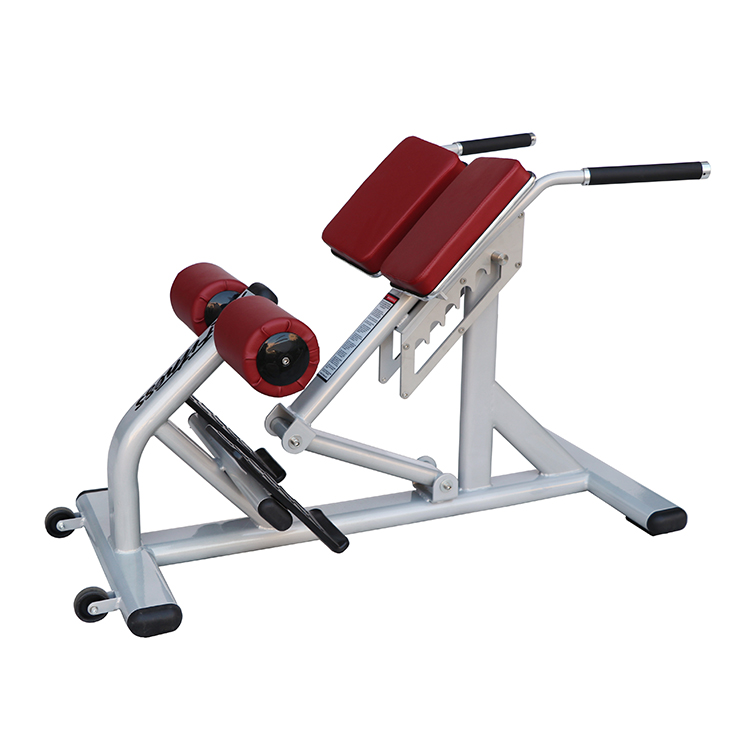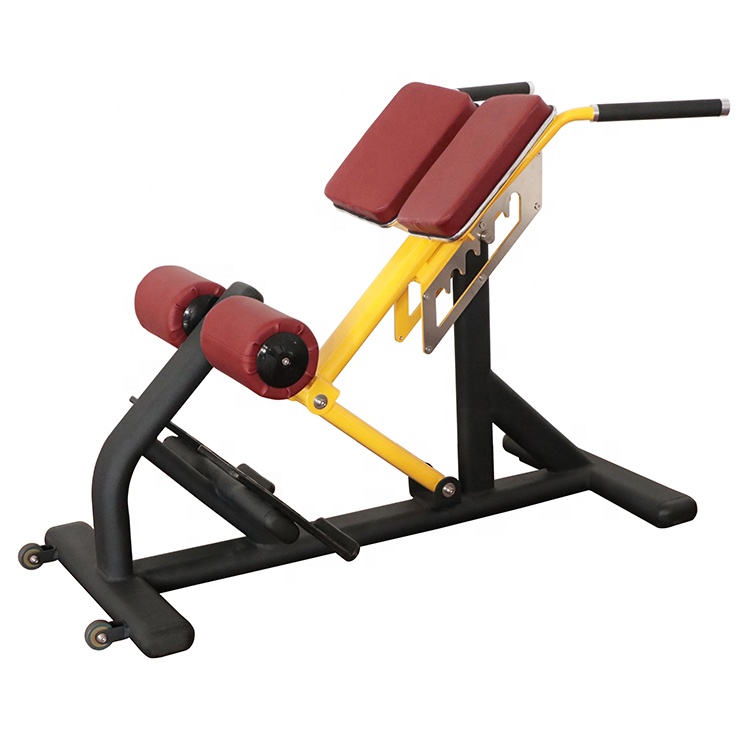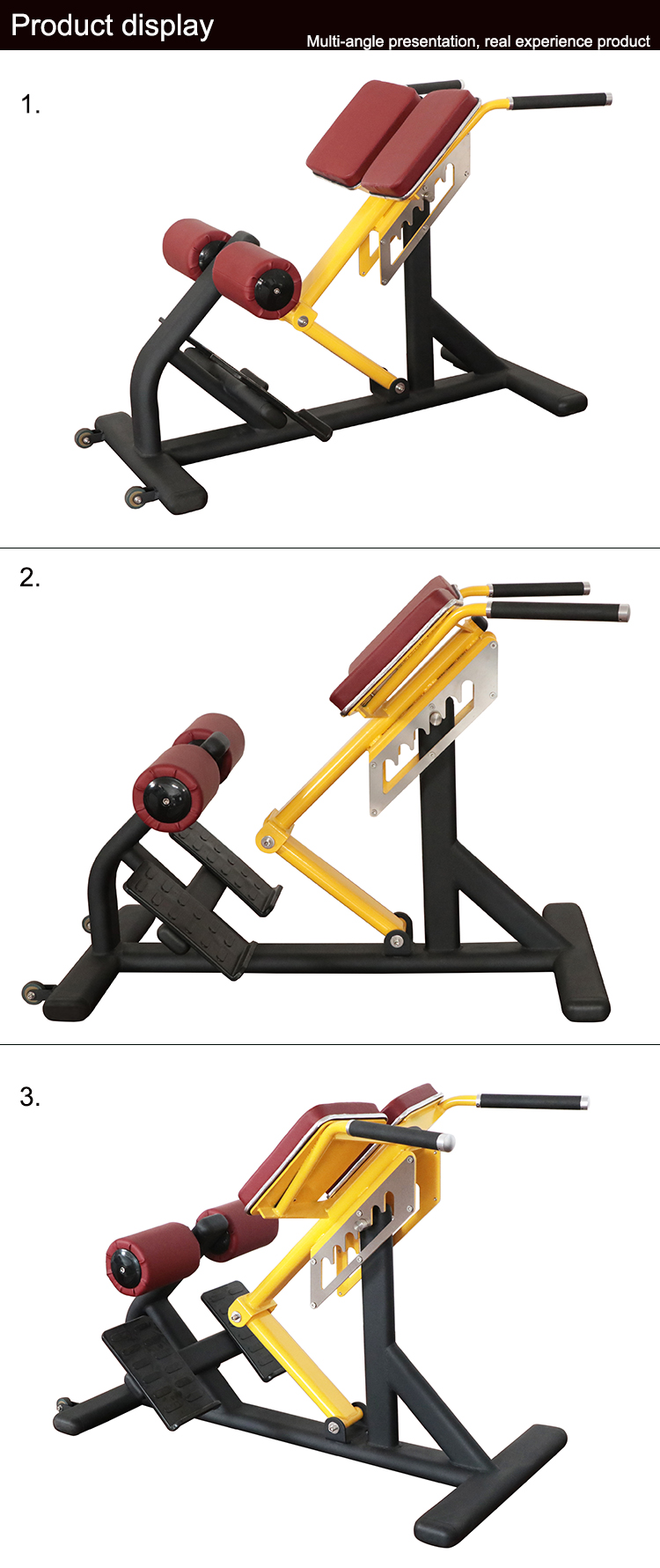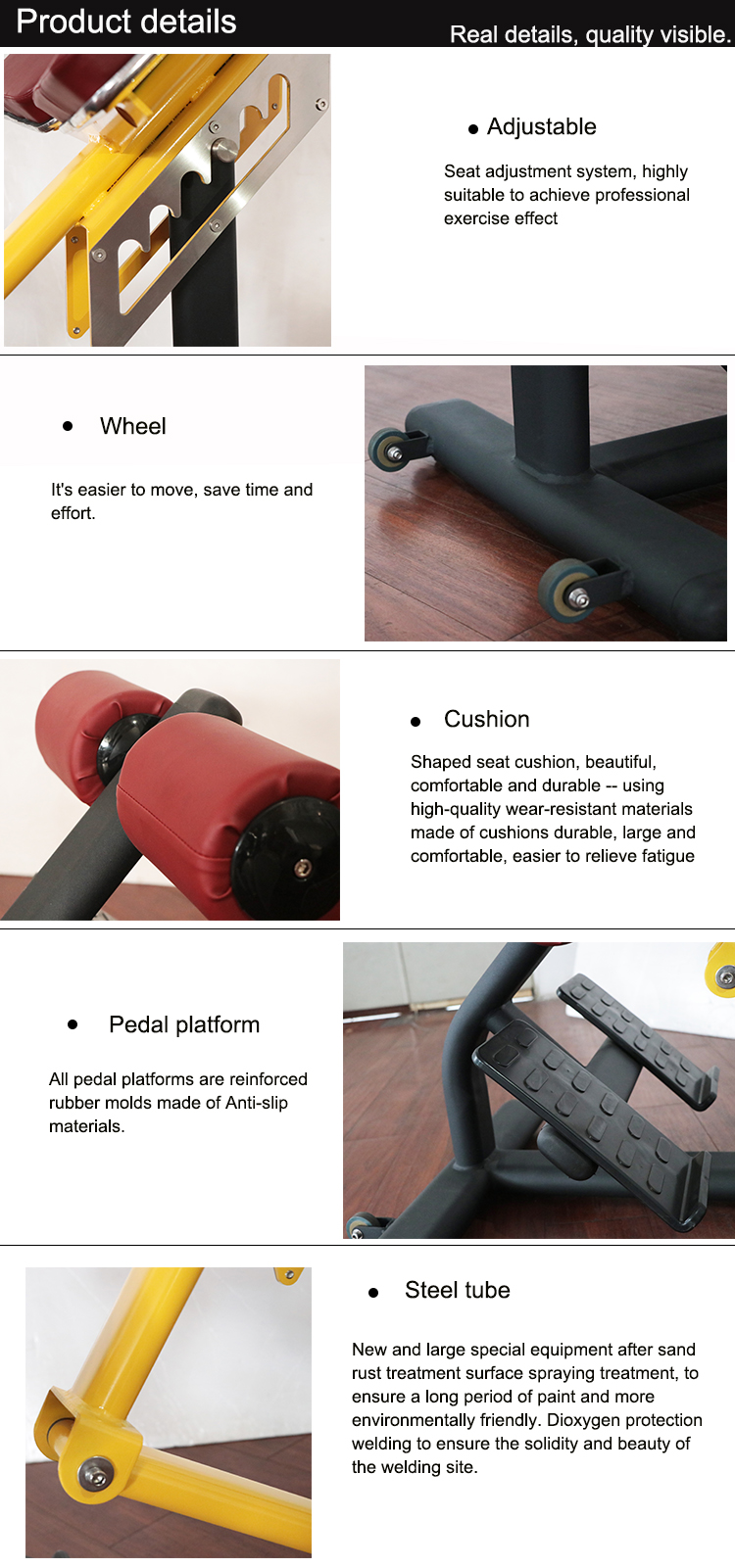
Privacy statement: Your privacy is very important to Us. Our company promises not to disclose your personal information to any external company with out your explicit permission.
"Enhance Your Professional Fitness Routine with the Versatile Adjustable Weight Bench and Roman Chair Back Muscle Trainer"
Model No.: LJ-5530
Place Of Origin: China
Material: Plate, Plate
Application: Commercial
Style: Modern
Whether To Fold: No
Gender: Unisex
Can Be Customized: Yes
Place Of Origin: Guangdong, China
Brand Name: LJFITNESS
Size: 127x94x97cm
Applications: Commercial
Equipment Type: back extension bench
Multifunctions: crunch bench
Color: Frame-Grey/Silver, Cushion-Blue/Red/Orange, etc
Special Cushion: New Melding &High Density Upholstered Seat Cushion
Warranty: Life-time on the frame structure
Good Service: Logo and stickers are customers options.
Applicable Occasions: Professional Best Gym,Hotel Gym,Fitness Club,Commercial Gym
Main Related Activities: Muscle training,strength fitness,body building
Machine Weight: 50kg
Packaging: use flat packaging and wrap up with contraction protective film to avoid scratch, bend and deformation in transportation and reduce transportation costs, or customized for all back extension bench
Transportation: Ocean,Land
Supply Ability: 5600 Piece/Pieces per Month Apply to regular back extension bench
Port: Shenzhen/Foshan/Guangzhou
Payment Type: L/C,Western Union,T/T,Cash payment
Incoterm: FOB,CFR,CIF,EXW
Introducing our Adjustable Weight Bench Roman Chair Back Muscle Trainer, designed to take your fitness routine to the next level. This versatile and sturdy equipment allows you to target and strengthen your back muscles effectively. With its adjustable design, you can customize the bench to suit your preferred workout intensity and comfort level. Made from high-quality materials, this muscle trainer ensures durability and stability during your exercises. Whether you're a beginner or a seasoned athlete, this Adjustable Weight Bench Roman Chair Back Muscle Trainer is a must-have addition to your home gym. Elevate your fitness journey and achieve your goals with this exceptional equipment.
Do back extensions train glutes?
Yes, back extensions can indirectly engage the glutes to some extent, but they primarily target the muscles in your lower back, particularly the erector spinae (the long muscles running along your spine), as well as the core muscles, including the rectus abdominis and the external obliques. When performing back extensions, you may feel a secondary activation of your glutes, especially if you maintain proper form and control throughout the movement.
To specifically train your glutes, exercises like squats, lunges, deadlifts, hip thrusts, or glute bridges are more effective. These movements place a direct emphasis on the gluteal muscles, helping to strengthen and shape them. However, incorporating back extensions into your workout routine can still contribute to overall lower body strength and development, including the glutes, when combined with targeted glute exercises.
Do back exercises make your waist smaller?
No, back exercises alone do not directly make your waist smaller. However, they can contribute to weight loss and improved muscle tone in the abdominal and back muscles, which might give the appearance of a more defined or slimmer waist. Engaging in a well-rounded fitness routine that includes both cardiovascular exercise for burning calories and strength training for toning muscles is essential for overall body shape, including the waist area.
To specifically target the waist, you may want to focus on exercises that work the abdominal muscles, such as crunches, planks, Russian twists, or Pilates. These exercises can help strengthen the core, which contributes to better posture and a more toned midsection. Remember that reducing body fat around the waist is also crucial, and this typically involves a combination of regular exercise and a balanced diet.
It's important to keep in mind that results may vary depending on individual factors like genetics, metabolism, and consistency with your fitness routine. Always consult with a healthcare professional before starting any new exercise program.
Do back extensions help sciatica?
Back extensions can potentially help alleviate some symptoms of sciatica, but they may not be the best exercise for everyone and should be approached with caution, especially if you have severe or chronic sciatica. Sciatica is typically caused by pressure on the sciatic nerve, which runs from the lower back down through the buttocks and legs, often due to issues like herniated discs or spinal stenosis.
Back extensions involve flexing and extending the lower back, which can strengthen the muscles around the spine and improve core stability. This can indirectly contribute to better support for the spine and reduce pressure on the nerves. However, if your sciatica is severe or accompanied by pain during these movements, it's crucial to consult with a healthcare professional or a physical therapist first.
They will assess your specific condition and recommend exercises that are safe and appropriate for you. In some cases, gentle stretching, pelvic tilts, or modified back extensions may be recommended. If you experience pain during back extensions, stop immediately and consult your doctor.
It's important to remember that a comprehensive treatment plan for sciatica often includes a combination of physical therapy, pain management, and lifestyle modifications, in addition to targeted exercises. Always listen to your body and avoid any movements that exacerbate your symptoms.
Are back extensions better than deadlifts for lower back?
Back extensions and deadlifts can both be beneficial for the lower back, but they target different muscle groups and aspects of spinal strength and stability.
1. Back Extensions: This exercise primarily targets the erector spinae muscles, which are the primary muscles that run along your spine from your neck to your pelvis. Back extensions work on developing the posterior chain strength, which includes the lower back muscles. They help improve core stability, posture, and the ability to maintain proper spinal alignment during movements like lifting. If you have a history of lower back pain or want to focus on strengthening the muscles that support your lower back, back extensions can be an effective exercise.
2. Deadlifts: Deadlifts are a compound exercise that engage a wide range of muscles, including the glutes, hamstrings, quadriceps, and, of course, the lower back (erectors). While the main focus is on the legs and posterior chain, deadlifts also provide a significant workout for the lower back. Deadlifts can help with overall strength, power, and spinal stability when performed with proper technique. However, they can place more stress on the lower back, so it's crucial to learn and maintain good form to prevent injury.
In summary, both exercises are beneficial for the lower back, but deadlifts are generally considered to be more comprehensive as they involve multiple muscle groups. If you're looking to strengthen the lower back specifically, back extensions can be a safer choice, while deadlifts should be approached with caution and proper coaching to ensure you don't place excessive strain on the area. It's essential to include a variety of exercises in your routine to target different aspects of spinal health and strength. Consult with a fitness professional to create a balanced training plan tailored to your individual needs and goals.
Can you do back extensions on a bench?
Yes, you can perform back extensions on a bench. Back extensions, also known as hyperextensions or seated back extensions, are an exercise that primarily target the erector spinae muscles, which run along the length of your spine. To perform back extensions on a bench:
1. **Equipment**: You will need a weight bench or a sturdy flat bench with a backrest.
2. **Setup**: Sit on the bench with your feet flat on the floor, hip-width apart. Your hands can either be behind your head, grasping the bench for support, or placed on your hips for a lighter version of the exercise.
3. **Position**: Position your body so that your lower back is pressed against the bench, and your knees are slightly bent if desired for stability.
4. **Execution**: Engage your core and glutes, then slowly lift your upper back off the bench by straightening your spine. Keep your lower back pressed against the bench and maintain a neutral spine throughout the movement. Aim to lift until your shoulders are level with or slightly above your knees.
5. **Control**: Lower yourself back down to the starting position while maintaining control, ensuring you don't arch your lower back.
6. **Reps and Sets**: Perform the desired number of repetitions, resting as needed between sets.
Remember to start with a light weight or no weight at all if you're new to the exercise, focusing on proper form before increasing the load. It's essential to keep good spinal alignment to avoid injury. If you have any concerns or health issues, consult a trainer or medical professional before attempting this exercise.
What is the difference between 45 degree and 90 degree back extensions?
45-degree and 90-degree back extensions are both exercises that target the muscles of the lower back, particularly the erector spinae (the long muscles running along the spine) and the glutes. However, they differ in terms of the range of motion and difficulty level.
1. 45-degree Back Extension:
In a 45-degree back extension, you typically lie on your stomach with your legs straight and one leg raised to a 45-degree angle from the ground. The other leg remains flat on the floor. You then engage your core and lower back muscles to lift your chest and upper body off the ground while keeping your torso at a 45-degree angle. This exercise provides a moderate challenge as it still engages a significant portion of your back muscles but with less weight or leverage compared to a full 90-degree extension.
2. 90-degree Back Extension:
A 90-degree back extension, also known as a hyperextension, involves lying face down on a bench or stability ball with your legs straight and together. Your hips are bent at a 90-degree angle, so your knees are above your hips. You lift your upper body and hips off the bench by engaging your lower back muscles, reaching for your toes or feet, and straightening your legs as much as possible. This movement requires more strength and flexibility in the lower back, making it generally more challenging than the 45-degree version.
In summary, the main differences are:
- Range of motion: 45-degree back extensions involve lifting your chest and upper body up to a 45-degree angle, while 90-degree extensions require you to straighten your legs almost completely.
- Difficulty level: 90-degree back extensions are generally considered more challenging due to the greater range of motion and load on the lower back muscles.
- Focus: Both exercises target the lower back, but 90-degree extensions may place more emphasis on the hamstrings and glutes, as they involve a greater stretch in those muscles.
Can you do back extensions on a sit up bench?
Yes, you can perform back extensions on a sit-up bench, also known as an exercise bench or utility bench. Back extensions are a great exercise for strengthening the erector spinae muscles, which run along your lower and middle back, as well as the latissimus dorsi muscles, which are part of your upper back.
Here's how to do back extensions on a sit-up bench:
1. **Positioning**: Lie faceup on the bench with your feet flat on the ground, hip-width apart. Your knees should be bent at a 90-degree angle, and your hands can rest behind your head, across your chest, or on the bench for support (avoid pulling on your neck).
2. **Setup**: Engage your core by drawing your belly button towards your spine. This will help stabilize your body during the movement.
3. **Execution**: Start with your lower back pressed firmly against the bench. Slowly arch your upper back off the bench, lifting your chest and head up while keeping your lower body stable. As you lift, focus on squeezing your shoulder blades together and pushing your heels into the floor for added activation of your back muscles.
4. **Movement**: Exhale as you extend your back, then inhale as you lower slowly back down to the starting position. Make sure to control the descent and avoid bouncing.
5. **Reps and Sets**: Aim for 3-4 sets of 8-12 repetitions, focusing on proper form and engaging your back muscles throughout the entire range of motion.
Remember to maintain good posture and listen to your body. If you have any existing back issues, consult with a healthcare professional before starting this exercise or making adjustments to your technique.
Commercial Adjustable Weight Bench Roman Chair Back Muscle Trainer Bench Press For Gym Use


Commodity Name roman chair back extension bench
Product Code LJ-5530
Brand LJFITNESS
Optional Colors mainframe-silver/grey/white,cushions-red/blue/orange,available to choose
Special Details 1)full auto-pipe bender
2)fine welding burnish
3)two tiers baking varnishing
4)accessories--laser cutting &accuracy of drill holes
5)Guide bar --high-carbon chromium bearing steel
6)special cushions with 40mm thickness inside &unique PU coated leather outside
7)automatic &smooth pulley of 90mm
8)new melding &open mould bakelite plate
Strongpoints 1)perfect design ideas from American professional experts
2)attractive appearance
3)excellent working skills &high-tech auto-machines
4)every product can be made according to your requirements
Main related activities Swimming,Boxing,Wresting,Shooting,High jump,Long jump,Kongfu,etc


A Roman chair is a piece of exercise equipment used for strengthening the lower back, glutes, and core muscles. It consists of a padded bench with a footrest and handles for stability. The user typically lies face down on the bench with their ankles secured under the footrest and performs exercises such as back extensions or hyperextensions. The Roman chair is commonly found in gyms and is used by people of all fitness levels to improve posture, stability, and overall strength.
Laijian's main products include Fitness Equipment/Gym Equipment/Strength Equipment/Roman Bench Press Weight/Adjustable Weight Bench Roman Chair/Roman Chair Back Muscle Trainer
Product Categories : Commercial Gym Equipment


Privacy statement: Your privacy is very important to Us. Our company promises not to disclose your personal information to any external company with out your explicit permission.

Fill in more information so that we can get in touch with you faster
Privacy statement: Your privacy is very important to Us. Our company promises not to disclose your personal information to any external company with out your explicit permission.